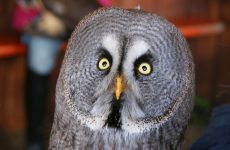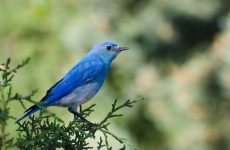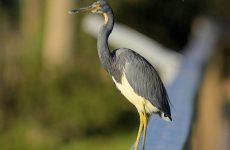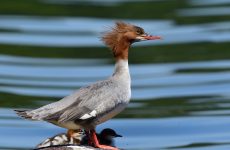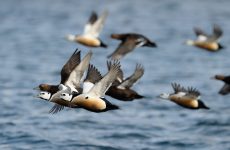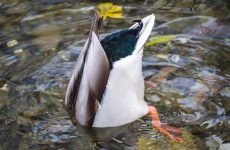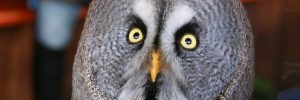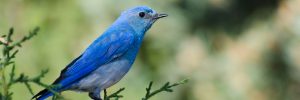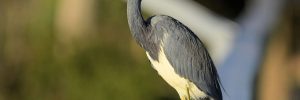There are other yellow finches than just the American Goldfinch, so check out this guide before you jump to conclusions.
If you need help identifying yellow finches in North America, then you have come to the right place. Get photos, identification help, bird calls, and what you need to know about where you might spot them and at what time of year.
All this information will really help you to identify those yellow finches. So take a look and see if you can spot the bird you are looking for.
8 Yellow Finches:
1. American Goldfinch
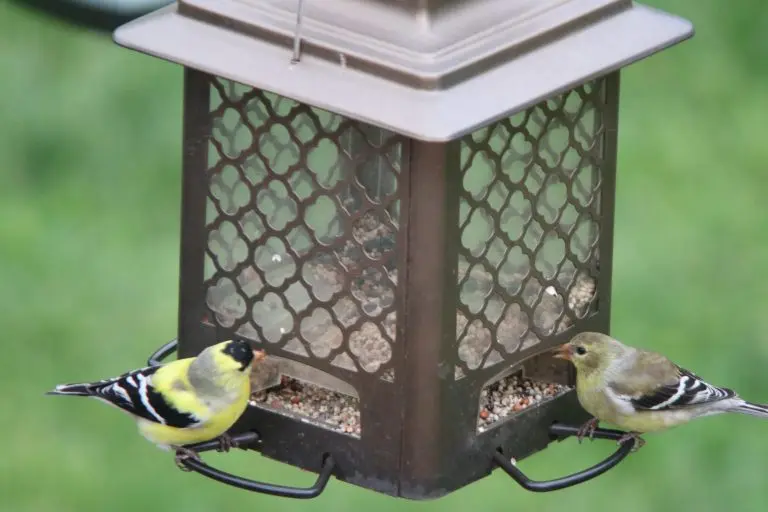
American Goldfinches are popular birds with the males’ bright yellow and black coloring in spring. The females are duller brown, as are males in winter.
- Spinus tristis
- Length: 4.3-5.1 in (11-13 cm)
- Weight: 0.4-0.7 oz (11-20 g)
- Wingspan: 7.5-8.7 in (19-22 cm)
American Goldfinches can be found in most of North America and are usually resident all year. However, those that breed in Canada and the Midwest migrate to southern US States for winter.
They can be found in weedy fields and overgrown areas foraging for sunflower, thistle, and aster plants. They are also common in suburbs, parks, and backyards.
American Goldfinch Song:
Attract American Goldfinches to your backyard by planting thistles and milkweed. They will visit most bird feeders and prefer sunflower seed and nyjer seed.
2. Lesser Goldfinch
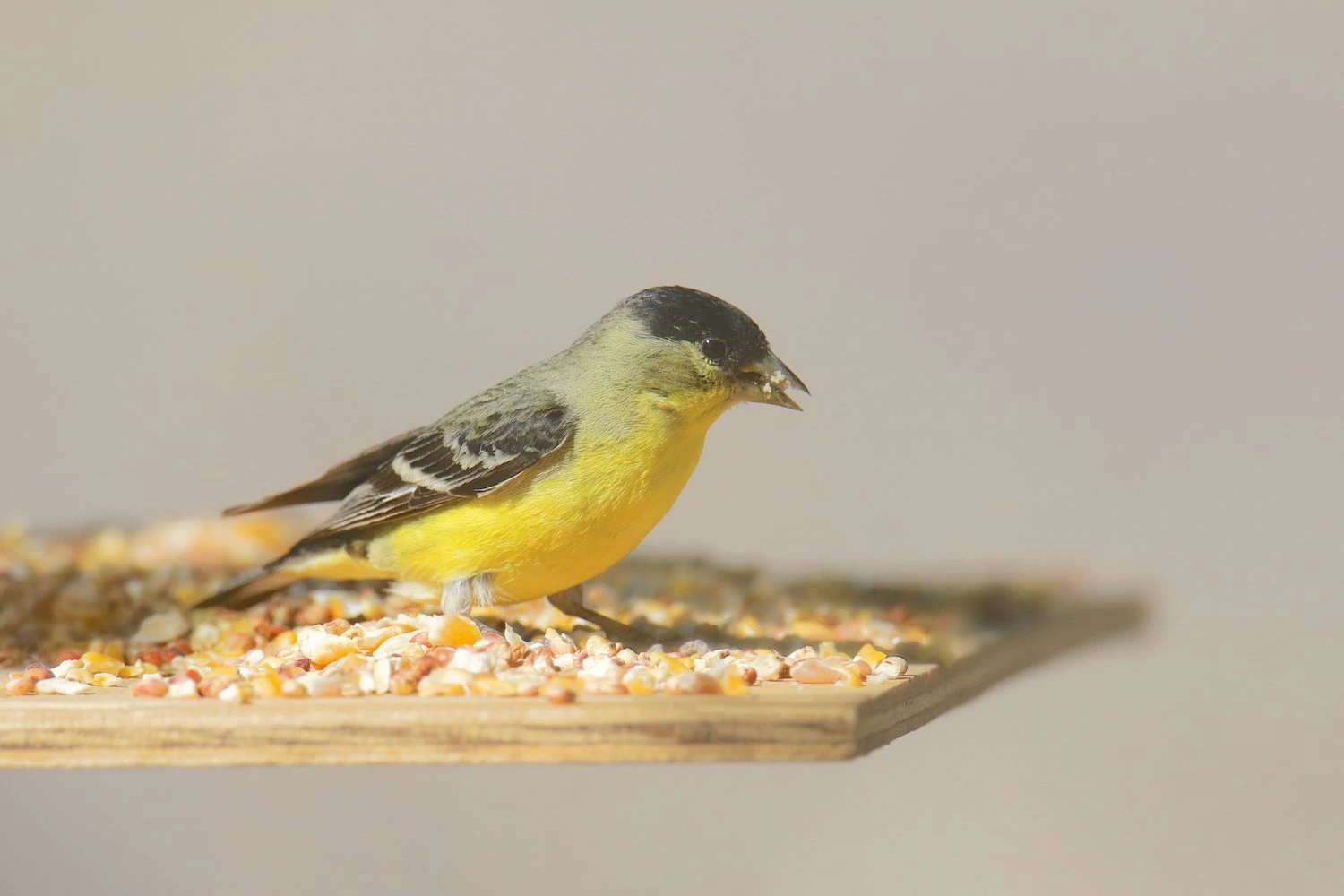
Lesser Goldfinches are tiny bright yellow and black songbirds with long pointed wings and short notched tails. Females have olive backs and are more dull yellow underneath.
- Spinus psaltria
- Length: 3.5-4.3 in (9-11 cm)
- Weight: 0.3-0.4 oz (8-11.5 g)
- Wingspan: 5.9-7.9 in (15-20 cm)
Lesser Goldfinches live in the southwestern US states and the West Coast all year, but those that breed in the interior of western US states migrate for winter.
Lesser Goldfinches can be found in large flocks in open habitats, including thickets, weedy fields, forest clearings, parks, and gardens. They forage for seeds, especially sunflower seeds, but also fruits from elderberry, coffeeberry, and buds from cottonwoods, willows, sycamores, and alders.
Lesser Goldfinch call/Song:
Attract Lesser Goldfinches to your yard with sunflower seeds and nyjer in tube feeders or platform feeders.
3. Pine Siskin
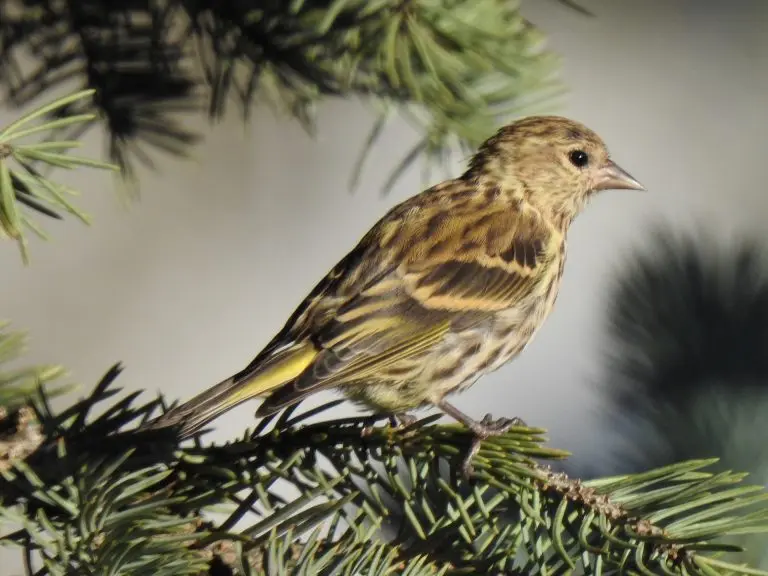
Pine Siskins are small brown finches with yellow streaks on the wing and tail. They have a forked tail and pointed wings, with a short pointed bill.
- Spinus Pinus
- Length: 4.3-5.5 in (11-14 cm)
- Weight: 0.4-0.6 oz (12-18 g)
- Wingspan: 7.1-8.7 in (18-22 cm)
Pine Siskins remain all year in the pine forests in the western states and along the Canadian Border. Some also breed in Canada before heading south for winter.
Depending on pine cone crops, they can be found over much of North America. As their name suggests, Pine Siskins predominantly eat seeds from conifers, but they also eat young buds and seeds from grasses and weeds.
Pine Siskin Song:
Nests of Pine Siskins are built ten to fifty feet high above the ground, away from the tree trunk. They are usually made of twigs, barks, and moss and are home to three to five eggs. It takes about thirteen days for the eggs to hatch.
Attract Pine Siskins to your backyards with thistle and nyjer feeders but also black oil sunflower seeds and suet.
Fun Fact: The name “Siskin” comes from the Pine Siskin’s chirp. So, it’s basically a “pine chirper.”
4. Evening Grosbeak
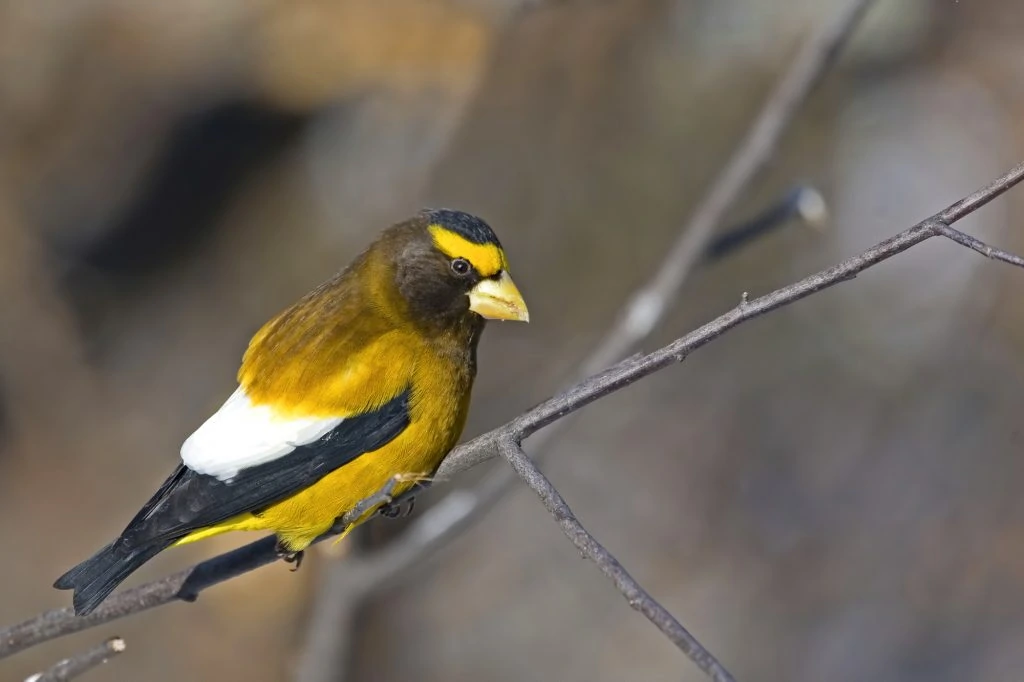
Evening Grosbeaks are chunky birds with big bills and a striking yellow and black pattern. Adult males have a bright yellow stripe over their eyes, making them look fierce. Their heads are black, with gray necks, and their chest and belly are yellow. They also have a white patch on their wings.
Females and juvenile males have greenish bills, mostly gray bodies, black and white wings, and a yellow tinge to the neck.
- Hesperiphona vespertina
- Length: 16 to 22 cm (6.3 to 8.7 in)
- Weight: 38.7 to 86.1 g (1.37 to 3.04 oz)
- Wingspan: 30 to 36 cm (12 to 14 in)
Evening Grosbeaks remain all year in southern Canada and down the west coast to northern California. However, when cone crops are poor, they will migrate south to most US states.
You can find Evening Grosbeaks in forests and mountain regions. During the winter, they’re often attracted to bird feeders in backyards, most often because it’s an easy food supply.
Evening Grosbeaks naturally feed on flower buds during spring; insect larvae from treetops during the summer; and in the winter, they flock to backyard feeders or feast on seeds, berries, and small fruit.
Evening Grosbeak Song:
Nests of Evening Grosbeaks are usually found up to 100 feet above ground in pine trees. The nests are loosely made, composed of twigs, rootlets, grass, moss, and pine needles. There are usually up to five eggs laid by the female, and she incubates them for two weeks until they hatch.
Attract Evening Grosbeaks to your backyard during winter with sunflower seeds, berries, and maple buds.
Fun Fact: Evening Grosbeaks have such powerful bills that they can crush seeds that are too hard to open for other smaller birds, so these birds hang around to eat whatever is left behind.
5. Lawrence’s Goldfinch
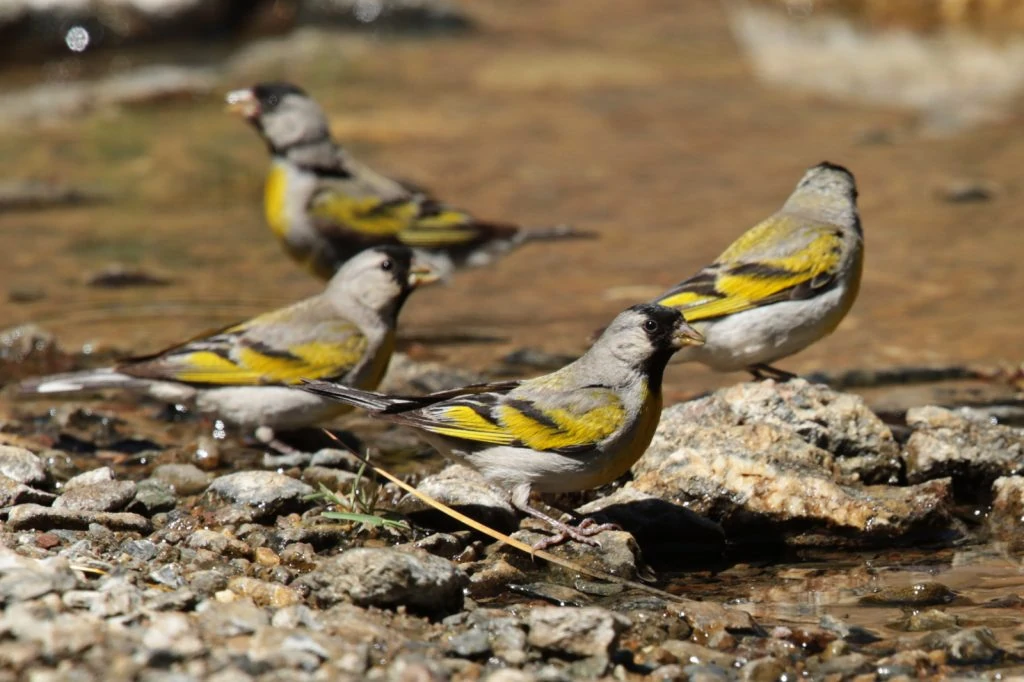
Lawrence’s Goldfinches are small, nomadic songbirds. The males are easily recognizable with a black vertical stripe from the front of their heads to their chins. Their body is mainly gray with a yellow breast, belly, wings, and back. Their wings are black with white tips.
Females have similar patterns but are slightly paler gray in color. Juvenile males look like females, but they’re even duller in color.
- Spinus lawrencei
- Length: 3.9-4.7 in (10-12 cm)
- Weight: 0.3-0.5 oz (9-14 g)
- Wingspan: 8.3 in (21 cm)
Lawrence’s Goldfinches breed in California and migrate a short distance east and south.
You can find Lawrence’s Goldfinch in open oak woodlands and shrubby areas, especially if there’s a nearby water source. In the winter, you can find them among weedy fields, brushy areas, and near streams.
Lawrence’s Goldfinch mostly eats seeds. They can even hang upside down from branches to reach them. There are times when they forage for food on the ground, and they will eat insects and buds.
Lawrence’s Goldfinch Song:
Nests of Lawrence’s Goldfinches are made with grass, flower heads, and feathers high up in trees, where they spend most of their time. Expect around six eggs in a nest, with the female in charge of incubation for nearly two weeks. Once they hatch, the female takes care of the young for about two more weeks. Give it another week, and the young are ready to leave the nest.
Fun Fact: Lawrence’s Goldfinches migrate from east to west instead of north to south, the opposite of other migratory birds.
6. Yellow-fronted Canary
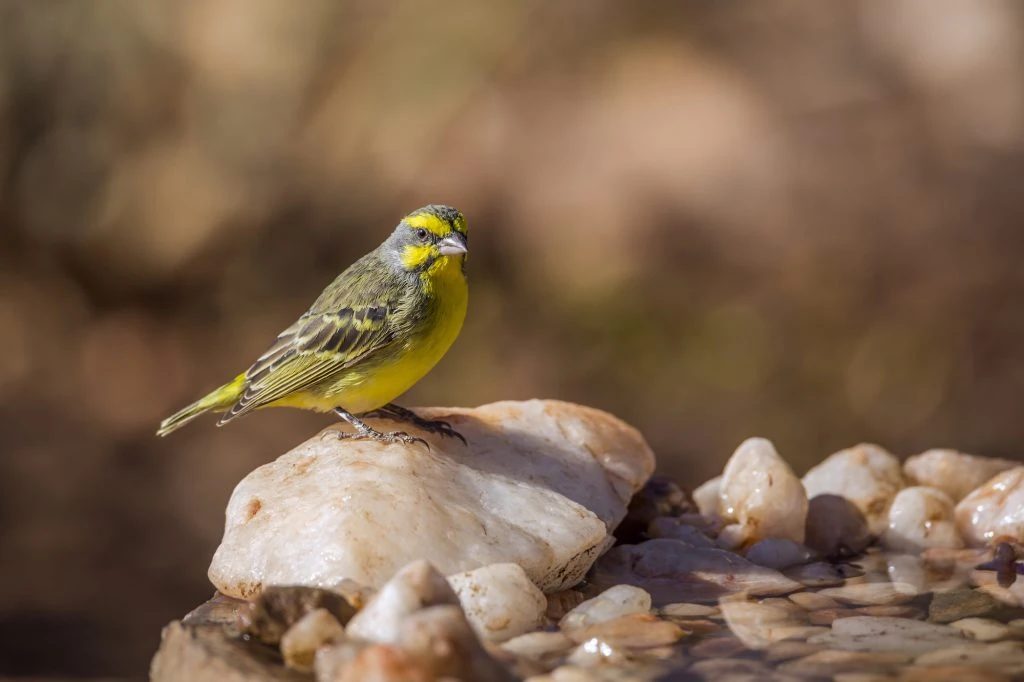
Male Yellow-fronted Canary are small birds with a yellow head, gray crown, and nape, with gray stripes across their cheeks and eyes. Their bodies are bright yellow, while their back and wings have a greenish-brown tinge. Females look almost the same but with a duller color.
- Crithagra mozambica
- Length: 4-5 in (11–13 cm)
- Weight: 0.57 oz. (16 g)
- Wingspan: 8.4-8.5 in (21-22 cm)
You can find Yellow-fronted Canary in open woodland, grasslands, sand dunes, mangroves,, and farmlands.
Yellow-fronted Canary feed on seeds and insects such as termites, aphids, and grasshoppers, and they will also eat leaves, fruit, and nectar.
Yellow-fronted Canary Song:
Nests of Yellow-fronted Canary are usually in trees, and they lay around four eggs. Eggs take about two weeks to hatch and another two weeks for the young to leave the nest.
Fun Fact: The Yellow-fronted Canary is also known as the Green Singing Finch.
7. Eurasian Siskin
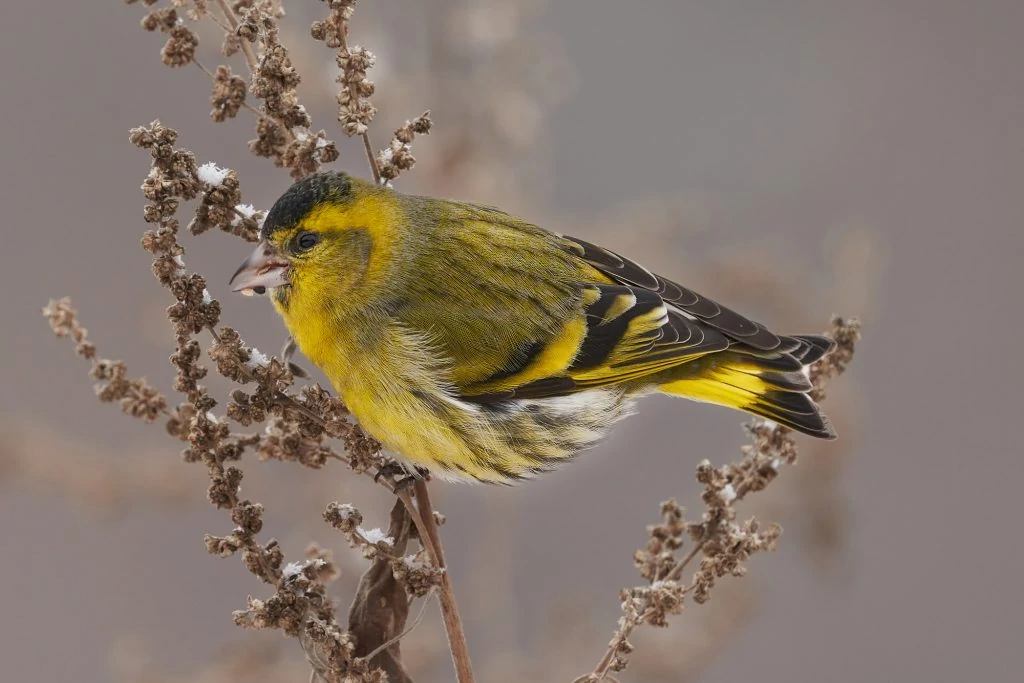
Male Eurasian siskins have a black cap on their heads and a black chin patch. Their face, breast, and the rest of the body are greenish-yellow. Their wings are black with distinct yellow wing bars. There are also yellow parts on both sides of their tail. Females and juveniles are yellowish with streaky lines.
- Spinus spinus
- Length: 5 inches (12.7 cm)
- Weight: 0.5 oz (14.2 g)
- Wingspan: 9 inches (22.9 cm)
Eurasian siskins are usually found in Europe and Asia, but they occasionally stray into Alaska and the northeast coast of the United States and Canada.
You can find Eurasian siskins in woodlands and forests. They are known to have unpredictable migratory patterns, seemingly going where there are plenty of seeds.
Eurasian siskins’ favorite food are seeds, especially alder and birch catkins. They prefer to eat in trees instead of on the ground. In spring, they feed in coniferous forests, eating seeds from elms and poplars. In summer, they add herbs like goosefoots and Compositae.
In autumn and winter, they join other finches in eating seeds from deciduous trees like birch and herbaceous plants like meadowsweet.
Eurasian Siskin Song:
Nests of the Eurasian siskin are safely hidden on a high branch of a conifer tree. Breeding pairs usually form colonies together with their nests close to each other. Nests are small and bowl-shaped, made out of twigs, grass, moss, and lichen, and it is softened with down feathers.
The females lay two to six eggs. It takes 10 to 14 days of incubation, and they leave the nests after fifteen days.
Fun Fact: In St. Petersburg, you will find a statue of a siskin because its colors are similar to the uniform of students from an elite school in the city. The students themselves bear the nickname, siskins.
8. Yellow Grosbeak
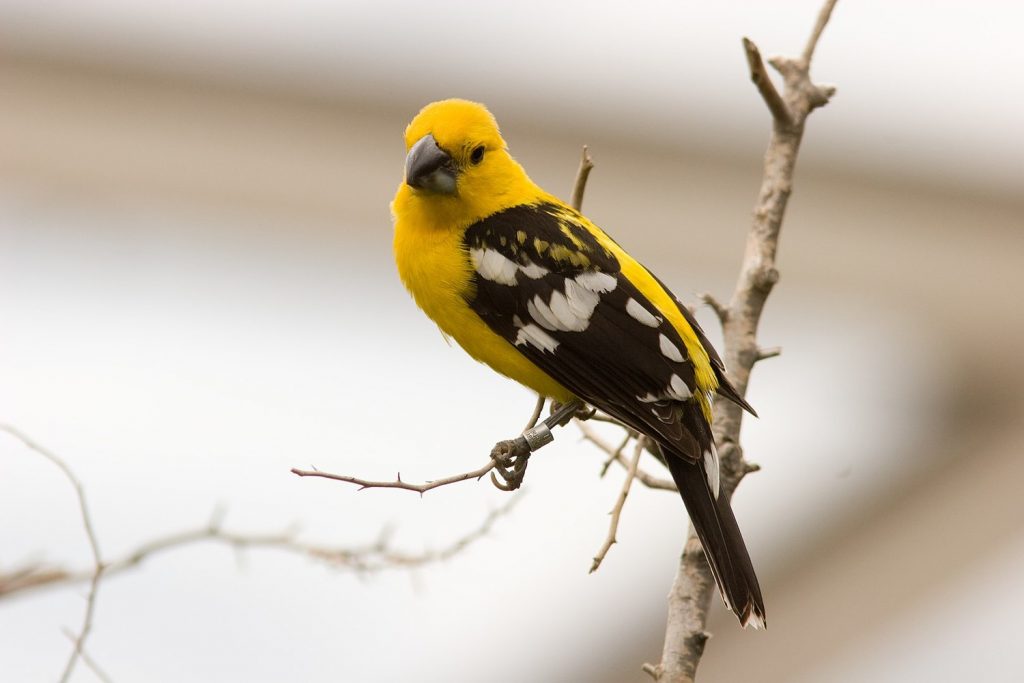
Yellow Grosbeaks are medium-sized birds with gray-black bills that seem too big for their bodies. The male’s head, chest, and belly are a bright, solid yellow color, with black wings dotted with white markings.
Females have a more subdued color, sometimes even olive-hued on the head and the rest of the body, while the wings are gray with white tips.
- Pheucticus chrysopeplus
- Length: 8.5 – 9.4 inches (21.5 – 24 cm)
- Weight: 2.2 oz (62g)
Yellow Grosbeaks live on the Pacific side of Mexico and into southern US states.
You can find the Yellow Grosbeak in tropical forests, woodlands, and shade-coffee plantations feeding on seeds, fruits, and berries. They also feast on insects.
Nests of Yellow Grosbeaks are commonly built on mid-level trees or in dense bushes. They are made using grass and sticks with other fine materials for lining them. The female lays around up to five eggs that incubate for about two weeks.
Attract Yellow Grosbeaks to your background by leaving sunflower seeds, apple slices, and peanut kernels in your bird feeders.

